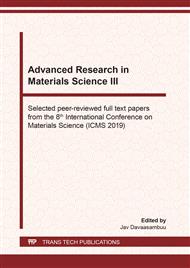[1]
W. Shan, W. Walukiewicz, K. M. Yu et al. Effect of nitrogen on the electronic band structure of group III-N-V alloys. Phys. Rev. B 62 (2000) 4211-4214.
Google Scholar
[2]
K. Nomura, H. Ohta, K. Ueda, et al. Thin-film transistor fabricated in single-crystalline transparent oxide semiconductor. Science 300 (2003) 1269-1272.
DOI: 10.1126/science.1083212
Google Scholar
[3]
K. Akita, T. Kyono, Y. Yoshizumi, et al. Improvements of external quantum efficiency of InGaN-based blue light-emitting diodes at high current density using GaN substrates. J. Appl. Phys. 101 (2007) 033104-1 - 033104-5.
DOI: 10.1063/1.2432307
Google Scholar
[4]
S. Nakamura. III–V nitride based light-emitting devices. Solid.State.Commun. 102 (1997) 237-243.
DOI: 10.1016/s0038-1098(96)00722-3
Google Scholar
[5]
H. Zhao, N. Tansu. Optical gain characteristics of staggered InGaN quantum wells lasers. J. Appl. Phys. 107 (2010) 113110-1 - 113110-12.
DOI: 10.1063/1.3407564
Google Scholar
[6]
Z. H. Zhang, Y. H. Zhang, W. G. Bi, et al. A charge inverter for III-nitride light-emitting diodes. Appl. Phys. Lett. 108 (2016) 151105-1 - 151105-5.
DOI: 10.1063/1.4947025
Google Scholar
[7]
H. Condori Quispe, S. M. Islam, S. Bader et al. Terahertz spectroscopy of an electron-hole bilayer system in AlN/GaN/AlN quantum wells. Appl. Phys. Lett. 111 (2017) 073102-1-073102-4.
DOI: 10.1063/1.4996925
Google Scholar
[8]
Y. H. Ben, F. Liang, D. G. Zhao et al. Different influence of InGaN lower waveguide layer on the performance of GaN-based violet and ultraviolet laser diodes. Superlatt. Microstruct. 133 (2019) 106208-1-106208-8.
DOI: 10.1016/j.spmi.2019.106208
Google Scholar
[9]
Z. Z. Yu, Q. Li, Q. G. Fan et al. Investigation on surface-plasmon-enhanced light emission of InGaN/GaN multiple quantum wells.Superlatt. Microstruct. 117 (2018) 200-206.
DOI: 10.1016/j.spmi.2018.03.034
Google Scholar
[10]
G.. H.Wang. Nonlinear intersubband optical absorption in semiparabolic quantum wells. Optik 125 (2014) 2374-2377.
DOI: 10.1016/j.ijleo.2013.10.116
Google Scholar
[11]
H. Hassanabadi, G. Liu, L. Lu. Nonlinear optical rectification and the second-harmonic generation in semi-parabolic and semi-inverse squared quantum wells. Sol. Stat. Commun. 152 (2012) 1761-1766.
DOI: 10.1016/j.ssc.2012.05.023
Google Scholar
[12]
O. Emine. Comparison of asymmetric double parabolic-inversed parabolic quantum wells for linear optical (1–2) transition. Optik 139 (2017) 256-264.
DOI: 10.1016/j.ijleo.2017.04.003
Google Scholar
[13]
N. T.Tien, N. N. T. Hung, T. T. Nguyen et al. Linear intersubband optical absorption in the semiparabolic quantum wells based on AlN/AlGaN/AlN under a uniform electric field. Physica B 519 (2017) 63-68.
DOI: 10.1016/j.physb.2017.05.038
Google Scholar
[14]
J. H.Yuan, N. Chen,Y. Zhang et al. Electric field effect on the second-order nonlinear optical properties in semiparabolic quantum wells. Physica E 77 (2016) 102-107.
DOI: 10.1016/j.physe.2015.11.011
Google Scholar
[15]
F. Ungan, J.C. Martínez-Orozco R.L. Restrepo et al. Nonlinear optical rectification and second-harmonic generation in a semi-parabolic quantum well under intense laser field: Effects of electric and magnetic fields. Superlatt. Microstruct. 81 (2015) 26-33.
DOI: 10.1016/j.spmi.2015.01.016
Google Scholar
[16]
E. Ozturk, I. Sokmen. Nonlinear intersubband transitions in a parabolic and an inverse parabolic quantum well under applied magnetic field. J. Lumin. 145 (2014) 387-392.
DOI: 10.1016/j.jlumin.2013.08.011
Google Scholar
[17]
E. B.Al, F.Ungan , U.Yesilgul et al. Effects of applied electric and magnetic fields on the nonlinear optical properties of asymmetric GaAs/Ga1-xAlxAs double inverse parabolic quantum well. Opt. Mater. 47 (2015) 1-6.
DOI: 10.1016/j.optmat.2016.03.043
Google Scholar
[18]
F. Ungan, U.Yesilgul, E.Kasapoglu et al. Effects of applied electromagnetic fields on the linear and nonlinear optical properties in an inverse parabolic quantum well. J. Lumin. 132 (2012) 1627-1631.
DOI: 10.1016/j.jlumin.2012.02.033
Google Scholar
[19]
F. Q.Zhao, X. X. Liang, S. L. Ban. Levels of a polaron in a finite parabolic quantum well. Int. J. Mod. Phys. B 15 (2001) 527-535.
DOI: 10.1142/s0217979201004642
Google Scholar
[20]
F. Q.Zhao, X. X. Liang, S. L. Ban. Influence of the spatially dependent effective mass on bound polarons in a finite parabolic quantum well. Euro. Phys. J. B 33, (2003) 3-8.
DOI: 10.1140/epjb/e2003-00134-3
Google Scholar
[21]
F. Q.Zhao, J. Gong, Energy of a polaron in a wurtzite nitride parabolic quantum well. Chin. Phys. Lett. 24 (2007) 1327-1330.
DOI: 10.1088/0256-307x/24/5/056
Google Scholar
[22]
T. Das, S. Panda, B.K. Panda. Nonlinear optical susceptibilities in the diffusion modified AlxGa1–xN/GaN single quantum well. Superlatt. Microstruct. 117 (2018) 105-114.
DOI: 10.1063/1.4980702
Google Scholar
[23]
S. Panda, T. Das, B. K. Panda. Nonlinear optical susceptibilities in InxGa1−xN/GaN hexagonal single quantum well under applied electric field. Superlatt. Microstruct. 135 (2019) 106238-1-106238-11.
DOI: 10.1063/5.0017236
Google Scholar
[24]
S. H. Ha, S. L. Ban. Binding energies of excitons in a strained wurtzite GaN/AlGaN quantum well influenced by screening and hydrostatic pressure. J. Phys.: Condens. Matter 20 (2008) 085218-1 - 085218-7.
DOI: 10.1088/0953-8984/20/8/085218
Google Scholar
[25]
S. Adachi. GaAs, AlAs, and AlxGa1− xAs: Material parameters for use in research and device applications. J. Appl. Phys. 58 (1985) R1-R29.
Google Scholar
[26]
D. Z. Y. Ting, Y. C. Chang, Γ-X mixing in GaAs/AlxGa1− xAs and AlxGa1− xAs/AlAs superlattices. Phys. Rev. B 36 (1987) 4359-4374.
DOI: 10.12681/eadd/7439
Google Scholar
[27]
A. R. Goni, K. Syassen, M. Cardona. Cardona M. Effect of pressure on the refractive index of Ge and GaAs. Phys. Rev. B 41 (1990) 10104-10110.
DOI: 10.1103/physrevb.41.10104
Google Scholar
[28]
N. Eseanu. Simultaneous effects of laser field and hydrostatic pressure on the intersubband transitions in square and parabolic quantum wells. Phys. Lett. A 374 (2010) 1278-1285.
DOI: 10.1016/j.physleta.2009.12.079
Google Scholar
[29]
A. Bercha, W.Trzeciakowski, M. Gładysiewicz-Kudrawiec et al. Photocurrent measurements of InGaN/GaN quantum wells under hydrostatic and uniaxial pressure. J. Appl. Phys. 125 (2019) 115702-1-115702-11.
DOI: 10.1063/1.5090099
Google Scholar
[30]
F. Yun, M. A. Reshchikov, L. He, et al. Energy band bowing parameter in AlxGa1− xN alloys. J. Appl. Phys. 92 (2002) 4837-4839.
DOI: 10.1063/1.1508420
Google Scholar


